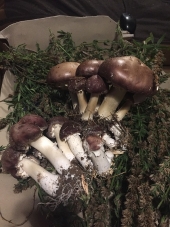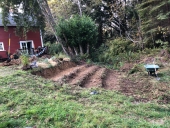posted 5 years ago
What's your ecosystem Caren? Here I would hammer in a stake for pole beans to go with the squash, and around the edge plant daikon radish - the long type that put down a long root. If the soil is compacted clay and mineral soil, it takes a long time to get enough roots in there helping you break it up. I've been letting Burdock help me with that in an area that a former owner put fill on and compacted with machinery and after 5 years only the areas I've really worked on are self-supporting and I've done a lot of horse-poop, duck-poop inoculated wood chips, dead animal, and veggie scrap compost windrows and I'm getting great soil out of the compost, but underneath is still pretty ugly. If any of it is moist enough you can use a really sturdy garden fork to push in, wiggle back and forth, and pull out, just to get the clay to have some cracks and gaps in it that roots can exploit (sort of the idea of keyline plowing on a very small scale), that might also help, but without some way to get moisture to penetrate enough that you can get a fork in, try that with caution, as I once tried jumping on the fork and the ground was so heavy I bounced off and had quite a tumble!
Another approach I took where our soil is really thin over clay/rock/mineral soil is I used a pick ax/shovel/every tool I had to dig a hole about 2 ft by 2 ft and then I kept filling it with anything that would compost along with a sprinkle of the dirt I'd removed. Everytime the level dropped, I added fresh organic matter topped with dirt. This added moisture as well as nutrients down deeper and encouraged earthworms to help you break up the soil from below. I've tended to do that near trees/shrubs I've planted, as the presence of goodies will encourage the plant roots to break up the soil also. In my ecosystem, the trees seek out underground dead wood and "mine" it.







